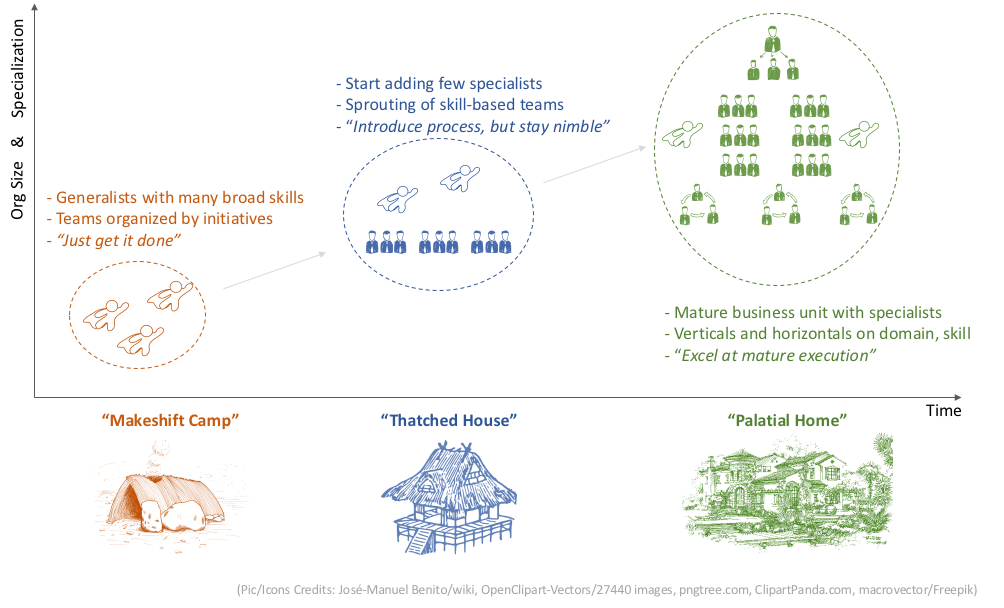Ready to learn Data Science? Browse Data Science Training and Certification courses developed by industry thought leaders and Experfy in Harvard Innovation Lab.
The growing pains of teams and some practical tips to tackle them
AI, or more reasonably data science is the claim to fame for every company that has even an iota of connection with data. They may just archive data from transactions, or at the other end, build cognitive models. But everyone aspires a play in analytics, and rightly so, given the huge unaddressed market.
But the big question is, where does one get started?
How can one source the talent and structure teams? And how to avoid the inevitable slow death facing many teams, due to lack of ROI or attrition. The industry staying in a state of flux makes this tougher — there are no standard guidelines for the mix of analytics skills, tools, technology or frameworks.
Firstly, what’s the need for Data science teams?
Going by any analyst estimate, hundreds of billions are being thrown in by companies to solve problems with data. The key ask is to draw actionable insights that can drive business decisions. Building of predictive models is the top-of-mind recall with the very mention of the word, ‘analytics’.
However, considerable business value in data science comes with the right application of exploratory analytics or statistical techniques. While AI or Deep learning have their rightful place, they are not silver bullets for Business ROI to every data problem.
The bottom line is the need for data science capability in organisations to identify pertinent solutions to business problems, by leveraging the data at hand. Companies see a lot of value in setting up a core, internal data science team (“build”), even if it has to be augmented by external providers (“buy”).
What are the 3 stages of Evolution of Data Science teams?

Photo by Todd Diemer on Unsplash
Let’s see how one can go about incubating a data science practice, or for that matter a startup with analytics offerings. Drawn from the lessons in building Gramener, I’ll trace the 3 distinctive phases of growth, focus areas and skills needed in each, and share intelligence on how to acquire the right talent.
Surprisingly, this scaling of data science teams has several similarities with how our forefathers built shelters over the ages. So, to throw in some fun, lets contrast each stage with the analogy of home-building and trace the rising sophistication across times: the stone age, middle age and the modern age.
Stage 1 : “Makeshift Camp

(Pic by José-Manuel Benito — Own work, Public Domain on wikimedia )
The best way to bootstrap a data science practice is by diving right in, with prioritised challenges, and a set of readily available tools. One must pick few urgent and critical business problems that can be solved by data, rather than boiling the ocean. Analytics is a long journey and a job begun is half done.
Similarly, too much of preparation for an ideal mix of skills could lead to analysis-paralysis. Onboard generalists, people who can cover many of the needed skills in analytics (say statistics, programming and information design), even if only to a limited depth. The need is for survivors who flourish in scarcity, wear many hats and instil dynamism to solve any given challenge.
Hiring such startup-stage superstars needs to be done unconventionally. Shun all regular channels. Tap into your network, speak and connect in conferences and send out feelers through tech evangelists. These early folks don’t come in for the job or perks, but for unbound challenges that feed their raw passion.
Start where you are. Use what you have. Do what you can. — Arthur Ashe
In our house-building analogy, we’re now in the stone age. To meet a basic physiological need, cavemen built basic, functional homes. Generalist skills that helped pick feasible sites, gather raw materials, design the most crude architectures, and a common sense to “get job done” was all that was needed.
Stage 2 : “Thatched House”

(Pic by OpenClipart-Vectors / 27440 images)
Having won small victories with the initial team and established a purpose, the data science team can start fanning out into adjacent usecases. Slowly expand the scope of problems addressed and deepen partnership with users. Initial pilots can now mature into longer initiatives spanning a quarter or year.
Showcase enhanced ROI to justify the next level of investment needed. While things may start to work in one’s favour, avoid over-committing in this interim stage. Start specialising by investing in few deeper areas (say Sales analytics, NLP), while continuing to be shallow and get job done in others (say design).
As the generalists continue to anchor the show, start filling more specialised roles. Expand hiring channels with hackathons, specialised finishing schools, while also up-skilling existing folks into data science. Start organising teams by the few areas of specialisation chosen, while keeping the vision broad, and response nimble.
Advance, and never Halt, for advancing is Perfection. — Khalil Gibran
As humans marched on, sophistication of house building shot up. Efficiency and effectiveness came about with slightly better raw materials and few core roles like masons, while generalists covered the rest. Inspite of dreams for a little more than a roof-over-the-head, function & purpose reigned supreme.
Stage 3 : “Palatial Home

(Pic by pngtree)
As an evolved entity, the data science team is essentially a mature business unit now. With specialised domain expertise and grasp over all key data science skill areas, the team is now ready to handle sufficiently complex problems, across a wide breadth of areas.
No longer faced with existential challenges, the team’s mandate can be deeply woven into long-term business objectives of the stakeholders. Teams could be structured with a vertical alignment, or as technical centres of excellence alias horizontals, or maybe along a hybrid, matrix structure which goes in between.
Fuel the fast-growing practice with mature hiring processes and in-house recruiters. For big and diverse numbers, cast the hiring net wide and far by adding conventional channels. Its critical to play a balancing act to retain early generalists, meet the aspirations of specialists, while also standardising processes to scale the organisation.
Perfection is not attainable, but if we chase perfection, we can catch excellence. — Vince Lombardi
Fast-forward to the modern age and we have construction firms that operate on scale. Specialised organisations own aspects of home-building like design, architecture, engineering. With form and function taken for granted, promise is for superior quality of life and nuanced aspects like elegance and usability.
Summar

3 Stages of Data Science teams evolution: Summary Illustration
We’ve looked at the 3 key stages of a data science team’s evolution. The emphasis in the first is on taking baby steps to get started quick-and-dirty, to accomplish small goals. The second involves taking measured strides, by bolstering capability in chosen areas, while staying a generalist in all others.
Finally, the third is more like pacing a marathon, where one must get the focus and process right, and be prepared to efficiently perform in the long haul. Thus, the focus in each stage, the skills and channels of hiring, and the guidelines to structure teams are drastically different across the 3 phases.
A failure to recognise this distinction can prove fatal for the practice, while an adept handling of these nuances can act as a nitro booster to unleash growth. And the key tenet that cuts across all three is delivery of actionable insights that drives business decisions, and brings in ROI for the data science dollars.



